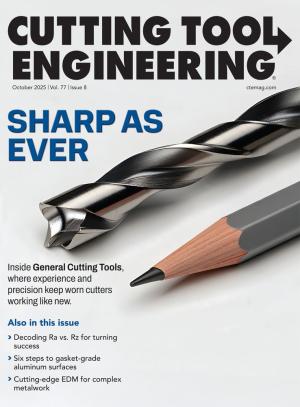We at Cutting Tool Engineering truly value reader feedback, be it a letter sent through the U.S. Postal Service, an email or a post to one of our social media channels. The reason is simple: your feedback tells the editorial team here whether we’re meeting your needs with the industry coverage we publish each issue.
CTE also relies on a reader feedback survey conducted by Signet Research Inc., an independent research firm that reaches out to a randomly selected sample of our subscribers to measure their reactions to content in a specific issue of our magazine. This year’s survey, which examined our June/July issue, successfully concluded with 144 respondents.
Signet measures reader reaction to editorial content by asking respondents if they recall seeing or reading each of the articles and columns published in a recent issue of a magazine. Signet then calculates an “Editorial Score” for each piece of editorial content. Generally speaking, a score of 130 or more is viewed as excellent; a score within the 116 to 129 range is considered strong; a score from 105 to 115 is good, and a score from 100 to 104 is considered normal.
Here’s how we fared with our June/July issue.
Excellent:
- “Intro to Thread Milling,” Brandt Taylor, our Machinist’s Corner columnist, shared knowledge he’s amassed across a career spanning five decades.
- “Understanding Hardness: Essential insights for machining experts,” a feature article by Erez Speiser, a 30-year industry veteran and founder of the Machining Doctor website.
- “Thank You to our Sponsors,” a message we run each issue thanking advertisers for their support.
Strong:
- “Smarter Setups,” a feature article about how tool presetters help shops do more with less.
Good:
- “Let Precision Be Your Guide,” a feature article about the role guide bushings play during Swiss-style machining.
- “Cobot Cuts Plasma Cutting Cycle Time,” a Productive Times case study about how a plasma cutter operated by a collaborative robot helped a shop improve cycle times and elevate overall efficiency when making porcelain-lined water heaters.
You can see how feedback such as this can help guide our editorial decision-making. That said, however, even a single message from one reader can provide valuable perspective. Such was the case with an email received from Roger Sustar, founder of the Alliance for Working Together (AWT) Foundation, which has 500-plus members from manufacturing companies, community organizations and schools who are engaged in promoting manufacturing careers.
“This was a wonderful article to read on ‘Workholding Insights’ in Cutting Tool Engineering magazine September 2025,” he wrote to the article’s author, CTE Contributor Christopher Tate, an engineering consultant with 32 years of experience in the metalworking industry. Adding an explanation point of his own, Sustar showed his appreciation for the last line of the article: “The critical thinking skills machinists acquire by using conventional machines will serve them well when the time comes!”
Or consider this recent email sent to Machinist’s Corner Columnist Brandt Taylor: “My name is Jake Paltauf. I have a machine shop here in Bedford, Virginia. I’m in the middle of a job very similar to the one you described in your article (“Machining Phenolic” in the September 2023 issue of Cutting Tool Engineering). I wanted to take a minute and say thank you for the excellent article you published about your experience in machining phenolic. This being my first time, I was nervous about getting going with the price of the material. After reading your article I have a great starting point in approaching this job. Thank you again.”
Related Glossary Terms
- gang cutting ( milling)
gang cutting ( milling)
Machining with several cutters mounted on a single arbor, generally for simultaneous cutting.
- lead angle
lead angle
Angle between the side-cutting edge and the projected side of the tool shank or holder, which leads the cutting tool into the workpiece.
- metalworking
metalworking
Any manufacturing process in which metal is processed or machined such that the workpiece is given a new shape. Broadly defined, the term includes processes such as design and layout, heat-treating, material handling and inspection.
- milling
milling
Machining operation in which metal or other material is removed by applying power to a rotating cutter. In vertical milling, the cutting tool is mounted vertically on the spindle. In horizontal milling, the cutting tool is mounted horizontally, either directly on the spindle or on an arbor. Horizontal milling is further broken down into conventional milling, where the cutter rotates opposite the direction of feed, or “up” into the workpiece; and climb milling, where the cutter rotates in the direction of feed, or “down” into the workpiece. Milling operations include plane or surface milling, endmilling, facemilling, angle milling, form milling and profiling.

